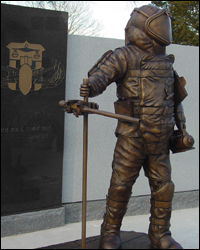|
Good morning. Thank you, Jeff Fuller, for that kind introduction.
I want to thank all of you for coming. And I want to thank everyone here who has been part of the creation of what I know will be a beautiful and lasting memorial. I'd also like to recognize Ronnie Carter, a fellow deputy director, with the Bureau of Alcohol, Tobacco, Firearms and Explosives.
The FBI is proud to partner with the Army in operating the Hazardous Devices Training School. Indeed, in the past 36 years, over 20,000 bomb technicians have been trained right here at Redstone Arsenal, the nation's only such school. We are also proud of that achievement.
We are here today to honor the lives and the dedicated work of 13 extraordinary individuals. They span a remarkable time frame—from March 12, 1909 to September 11, 2001.
They are individuals who did what many think of as the unthinkable—they walked straight into the face of danger in order to protect each of us.
Individuals like Lt. Giuseppe Petrosino of the New York City Police Department, who, in 1909, commanded a five-man unit investigating bombings by members of a criminal gang known as the Black Hand. Today, the NYPD bomb squad is the oldest active public safety bomb disposal unit in the United States.
 |
| The memorial features a bronze statue and a wall inscribed with the names of 13 bomb technicians who have lost their lives in the line of duty. |
Individuals like Officer Jeremiah Hurley of the Boston Police Department, who was killed while investigating a call regarding a suspicious package.
Individuals like Officer Ronald Ball and Detective Arleigh Eugene McCree of the Los Angeles Police Department. Both were killed in 1986 while attempting to render safe two pipe bombs.
Individuals like FBI Special Agent Leonard Hatton and NYPD Detective Danny Richards, both killed on that fateful day when the twin towers crashed to the ground in New York City.
Each of these men, along with seven other heroes whose names are inscribed on this wall and will be read shortly, gave their lives so that the rest of us might live in a safer world.
We honor each man with this memorial, which is proof that we will not forget their sacrifices. Each of these men also represents thousands of others who have dedicated their lives in the same way these men did.
It is most fitting that the Biblical phrase from Isaiah, “Here am I, send me,” is inscribed on this memorial.
The phrase beautifully summarizes the selflessness of individuals who routinely go against basic human instinct and purposely put themselves in harm's way so that others can be protected.
For some, such qualities flow naturally from their sworn obligation to protect and serve. Bomb technicians are smart, energetic, and persistent. And they work incredibly hard.
Bomb technicians also must be alert, suspicious, innovative, and mature. Someone once compared them to the knights of old, putting on their armor to go into battle.
Bomb technicians clearly exhibit steady resolve and keenness under pressure, matching their wits against a bomber's. They don't defuse bombs for money or for glory. They do it for us.
They are strong, and they are brave. And they refuse to give up.
The citizens of our nation depend on individuals with such character traits. And we owe them a profound debt of gratitude. Yet in most instances, their battle is one of the most stressful jobs imaginable.
Nearly every day in this country, police bomb squads respond to a scare or a suspicious package. The individuals who answer those calls are in a line of work where there is no room for error.
And there has been a sharp increase in such reports since 9/11, because that fateful day made the public much more aware that a briefcase, suitcase, or grocery bag might just also be a bomb.
Most often such calls turn out to be hoaxes or false alarms, but no call can go unanswered.
Indeed, it is because of this school that first responders around the country can so ably assist in disposing hazardous explosive materials and improvised explosive devices throughout the country.
The Hazardous Devices School also is doing a terrific job helping the FBI in achieving its number 1 priority: to prevent another terrorist attack.
Individuals who come to Huntsville for training go back to their homes in this country and around the world much better equipped to answer terrorism threats, including dealing with weapons of mass destruction.
Today, there are over 2,800 active bomb technicians from federal, state, local, and other agencies representing some 470 nationally accredited bomb squads. They are a testament to the excellent training that they receive here at Redstone.
The statue of the bomb technician that faces the entrance to the Hazardous Devices School is especially meaningful. It stands as a reminder to those who come here to train of just what the ultimate sacrifice can be.
It is our hope that this memorial and its tribute to the lives of these extraordinary individuals who paid the ultimate price to protect others will also inspire the students who come here to learn.
For each of us, this memorial serves as a lasting reminder of this dedicated group of public servants: ordinary citizens who led, and lead, extraordinary lives.
Thank you all for coming, and thank you for having me here today.
Executive
Speeches | Press Room Home
|


